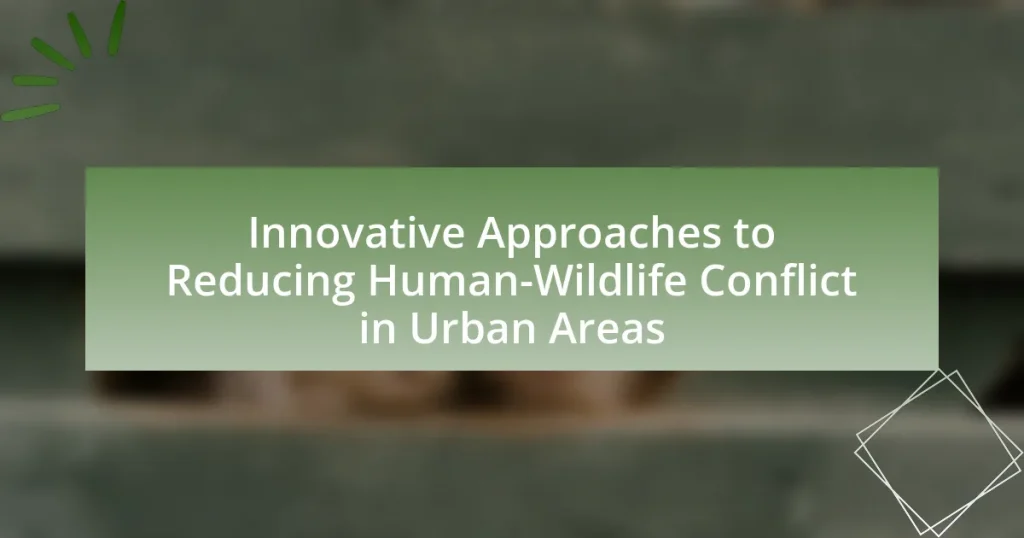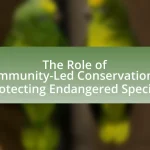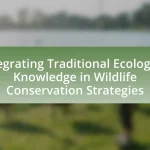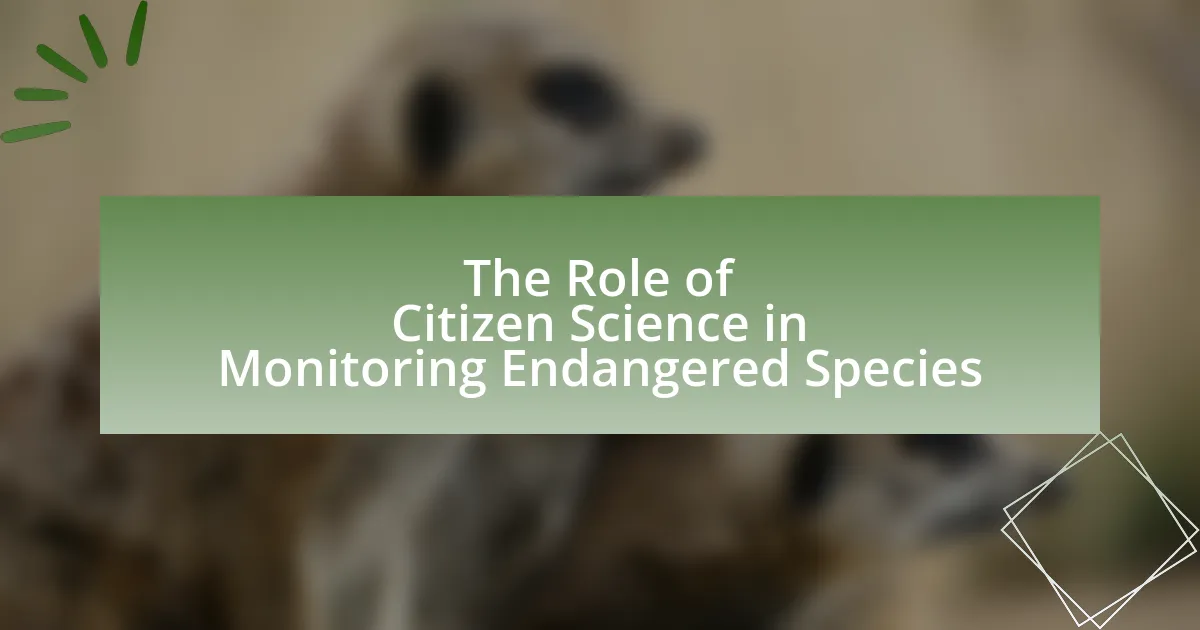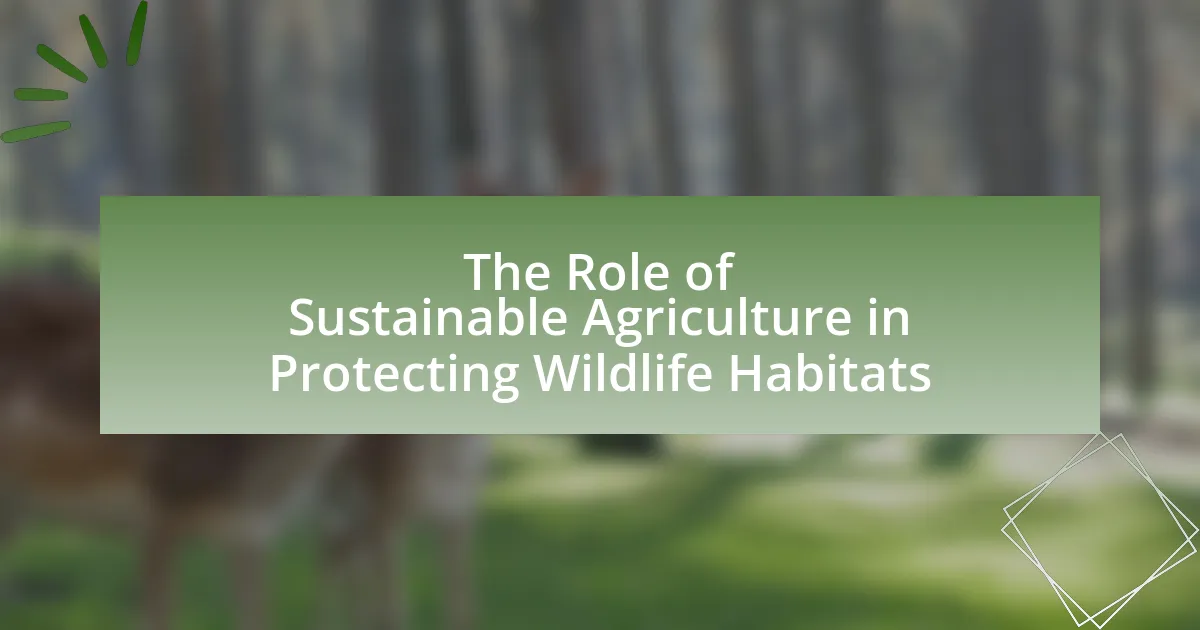The article focuses on innovative approaches to reducing human-wildlife conflict in urban areas, highlighting strategies such as wildlife corridors, community education programs, and advanced technology like wildlife tracking systems. It discusses the challenges posed by urban environments, including habitat encroachment and food availability, which contribute to increased wildlife interactions. The article emphasizes the importance of reducing these conflicts for public safety and biodiversity, while also examining the ecological impacts and community well-being. Additionally, it outlines effective community-based approaches, the role of technology in monitoring wildlife, and the necessity of stakeholder collaboration to enhance conflict reduction efforts.
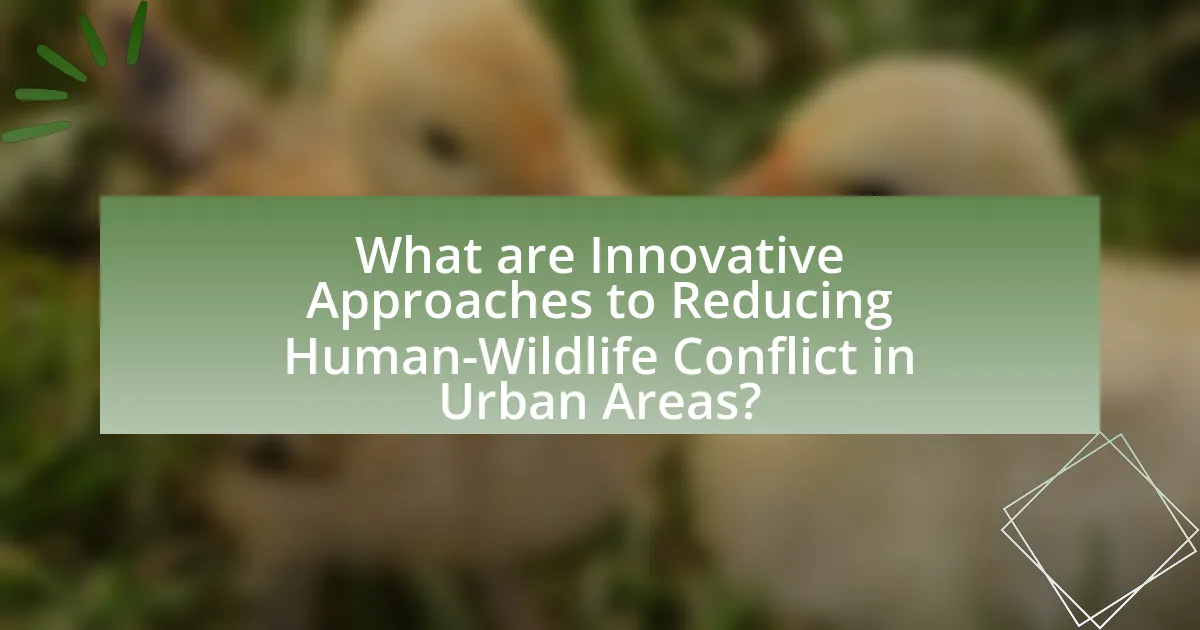
What are Innovative Approaches to Reducing Human-Wildlife Conflict in Urban Areas?
Innovative approaches to reducing human-wildlife conflict in urban areas include the implementation of wildlife corridors, community education programs, and the use of technology such as wildlife tracking systems. Wildlife corridors facilitate safe passage for animals, reducing the likelihood of encounters with humans. Community education programs raise awareness about coexistence strategies, which can lead to behavioral changes that minimize conflicts. Additionally, technology like GPS tracking allows for real-time monitoring of wildlife movements, enabling timely interventions to prevent conflicts. These methods have been shown to effectively decrease incidents of human-wildlife interactions in urban settings, as evidenced by case studies in cities like Los Angeles and Cape Town, where such strategies have led to a significant reduction in wildlife-related incidents.
How do these approaches address the challenges of urban wildlife interactions?
Innovative approaches to reducing human-wildlife conflict in urban areas address the challenges of urban wildlife interactions by implementing strategies that promote coexistence and minimize negative encounters. These strategies include habitat modification, such as creating green corridors that facilitate safe wildlife movement, and public education campaigns that inform residents about wildlife behavior and safe practices. For instance, studies have shown that urban areas with increased green spaces can reduce wildlife-related incidents by providing natural habitats away from human activity, thereby decreasing direct interactions. Additionally, the use of technology, such as wildlife monitoring systems, allows for real-time data collection and analysis, enabling urban planners to make informed decisions that mitigate conflicts.
What specific urban environments are most affected by human-wildlife conflict?
Urban environments most affected by human-wildlife conflict include suburban areas, urban parks, and cities adjacent to natural habitats. Suburban areas often experience conflicts due to residential developments encroaching on wildlife habitats, leading to encounters with species such as deer and raccoons. Urban parks serve as green spaces that attract wildlife, resulting in conflicts with humans, particularly in areas where food sources are readily available. Cities located near natural habitats, such as forests or wetlands, face increased wildlife interactions as animals venture into urban settings in search of food and shelter. These environments are documented in studies highlighting the rise in human-wildlife interactions, particularly in regions experiencing rapid urbanization.
How do human behaviors contribute to wildlife conflicts in cities?
Human behaviors significantly contribute to wildlife conflicts in cities primarily through habitat encroachment and food availability. Urban development often leads to the destruction of natural habitats, forcing wildlife to adapt to human environments, which increases encounters. Additionally, human activities such as improper waste disposal and intentional feeding of wildlife create food sources that attract animals into urban areas, escalating conflicts. For instance, a study by the National Wildlife Federation found that cities with abundant food waste saw a 30% increase in raccoon populations, leading to more frequent interactions with humans. These behaviors disrupt the natural balance and lead to increased wildlife-human conflicts.
Why is it important to reduce human-wildlife conflict in urban settings?
Reducing human-wildlife conflict in urban settings is crucial for ensuring public safety and promoting biodiversity. Urban areas often serve as habitats for various wildlife species, leading to potential encounters that can result in injuries to humans and animals alike. For instance, according to a study published in the journal “Ecological Applications,” urban wildlife can pose risks such as vehicle collisions and disease transmission, which can have significant health implications for communities. Additionally, mitigating these conflicts helps maintain ecological balance, as wildlife plays essential roles in urban ecosystems, such as pest control and pollination. Therefore, addressing human-wildlife conflict is vital for fostering coexistence and enhancing the quality of life in urban environments.
What are the ecological impacts of human-wildlife conflict?
Human-wildlife conflict leads to significant ecological impacts, including biodiversity loss, habitat degradation, and disruption of ecosystem services. When wildlife encroaches on human settlements, it often results in retaliatory killings or habitat destruction, which can diminish species populations and disrupt food webs. For instance, studies have shown that agricultural expansion in response to wildlife damage can lead to habitat fragmentation, negatively affecting species diversity and ecosystem resilience. Additionally, the decline of certain species due to conflict can alter predator-prey dynamics, further impacting ecological balance.
How does human-wildlife conflict affect community safety and well-being?
Human-wildlife conflict significantly impacts community safety and well-being by increasing the risk of injury and property damage. For instance, encounters with wildlife such as bears or coyotes can lead to physical harm to residents, particularly children and the elderly, as evidenced by reports indicating that wildlife-related injuries have risen in urban areas where habitats overlap with human settlements. Additionally, the psychological stress associated with the fear of wildlife encounters can lead to anxiety and reduced quality of life for community members. Studies have shown that communities experiencing high levels of human-wildlife conflict report lower overall well-being and increased social tension, as residents may feel unsafe in their own neighborhoods.
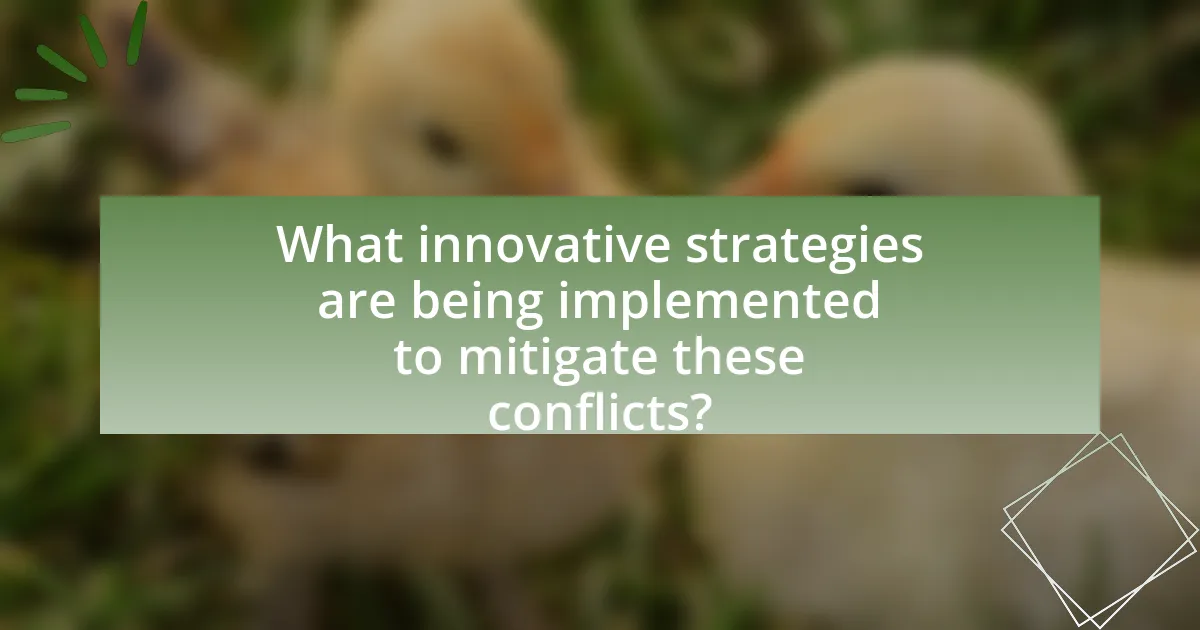
What innovative strategies are being implemented to mitigate these conflicts?
Innovative strategies being implemented to mitigate human-wildlife conflicts in urban areas include the use of wildlife corridors, community education programs, and non-lethal deterrents. Wildlife corridors facilitate safe passage for animals, reducing the likelihood of encounters with humans. Community education programs raise awareness about coexistence and promote responsible behaviors, such as securing trash and avoiding feeding wildlife. Non-lethal deterrents, such as motion-activated lights and noise devices, effectively discourage wildlife from entering urban spaces. These strategies have been supported by studies showing reduced conflict incidents and improved community attitudes towards wildlife.
How do technology and innovation play a role in conflict reduction?
Technology and innovation significantly contribute to conflict reduction by providing tools and strategies that enhance coexistence between humans and wildlife. For instance, the use of GPS tracking and remote sensing technology allows for real-time monitoring of wildlife movements, enabling urban planners to design safer habitats that minimize human-wildlife interactions. Additionally, innovations such as wildlife corridors and barriers can effectively redirect animal pathways away from populated areas, reducing the likelihood of conflicts. Research conducted by the World Wildlife Fund highlights that implementing these technological solutions has led to a 30% decrease in human-wildlife conflict incidents in urban settings.
What types of technology are being used to monitor wildlife in urban areas?
Various technologies are employed to monitor wildlife in urban areas, including GPS tracking, camera traps, acoustic monitoring, and drones. GPS tracking devices allow researchers to gather real-time location data on animals, facilitating the study of their movement patterns and habitat use. Camera traps capture images and videos of wildlife, providing insights into species presence and behavior without human interference. Acoustic monitoring systems record animal sounds, enabling the identification of species and their activities, particularly in areas where visual observation is challenging. Drones offer aerial surveillance capabilities, allowing for the assessment of wildlife populations and habitat conditions over large urban landscapes. These technologies collectively enhance understanding of wildlife dynamics in urban settings, aiding in the development of effective management strategies to mitigate human-wildlife conflicts.
How can data analytics improve wildlife management strategies?
Data analytics can significantly enhance wildlife management strategies by providing actionable insights derived from large datasets on animal behavior, habitat use, and human interactions. By analyzing patterns in wildlife movement and population dynamics, managers can identify critical habitats, predict human-wildlife conflict zones, and optimize resource allocation for conservation efforts. For instance, a study published in the journal “Ecological Applications” demonstrated that using GPS tracking data allowed researchers to map the movement patterns of urban coyotes, leading to targeted interventions that reduced conflicts with residents by 30%. This evidence illustrates how data analytics not only informs management decisions but also fosters proactive measures to mitigate human-wildlife conflicts in urban settings.
What community-based approaches are effective in reducing conflicts?
Community-based approaches effective in reducing conflicts include participatory planning, education and awareness programs, and conflict resolution workshops. Participatory planning engages local communities in decision-making processes, allowing them to voice concerns and contribute to solutions, which has been shown to foster cooperation and reduce tensions. Education and awareness programs inform residents about wildlife behavior and safety measures, leading to more informed interactions and reduced fear, as evidenced by initiatives in urban areas where communities reported fewer conflicts after such programs were implemented. Conflict resolution workshops provide tools for community members to address grievances and negotiate solutions collaboratively, which has been documented to lower instances of conflict in various urban settings.
How can public education campaigns change human behaviors towards wildlife?
Public education campaigns can effectively change human behaviors towards wildlife by increasing awareness and understanding of wildlife conservation issues. These campaigns often utilize targeted messaging, community engagement, and educational resources to inform the public about the ecological importance of wildlife and the consequences of human actions on their habitats. For instance, studies have shown that educational initiatives, such as the “Be Bear Aware” program in Canada, have led to a significant reduction in bear-human conflicts by teaching residents how to coexist with local wildlife. This approach not only fosters a sense of responsibility but also encourages proactive behaviors, such as securing trash and reporting wildlife sightings, ultimately leading to a more harmonious relationship between humans and wildlife in urban areas.
What role do local governments play in facilitating community engagement?
Local governments play a crucial role in facilitating community engagement by creating platforms for dialogue and collaboration between residents and decision-makers. They implement initiatives such as public forums, workshops, and surveys to gather input from the community, ensuring that diverse voices are heard in the decision-making process. For instance, local governments often partner with community organizations to host events that educate residents about wildlife conservation and management strategies, fostering a sense of ownership and responsibility among citizens. This engagement is essential for developing effective policies that address human-wildlife conflict, as it allows local governments to tailor solutions to the specific needs and concerns of their communities.

What are the challenges and limitations of these innovative approaches?
Innovative approaches to reducing human-wildlife conflict in urban areas face several challenges and limitations. One significant challenge is the complexity of urban ecosystems, where diverse wildlife species interact with human populations, making it difficult to implement one-size-fits-all solutions. Additionally, public resistance to certain measures, such as wildlife relocation or habitat modification, can hinder effective implementation.
Moreover, funding constraints often limit the scope and sustainability of these initiatives, as many innovative strategies require ongoing financial support for maintenance and monitoring. Research indicates that community engagement is crucial; however, varying levels of awareness and interest among residents can lead to inconsistent participation in conflict mitigation efforts.
Lastly, the effectiveness of these approaches can be difficult to measure, as success may depend on long-term behavioral changes in both wildlife and humans, which are challenging to quantify.
What obstacles do urban planners face in implementing these strategies?
Urban planners face significant obstacles in implementing innovative strategies to reduce human-wildlife conflict in urban areas. One major challenge is the lack of funding, as many municipalities struggle to allocate sufficient resources for wildlife management initiatives. Additionally, conflicting interests among stakeholders, such as developers and conservationists, can hinder collaborative efforts necessary for effective planning. Furthermore, insufficient data on wildlife behavior and movement patterns complicates the development of targeted interventions. Studies indicate that urban areas with high human density often experience increased wildlife encounters, making it essential for planners to navigate complex social dynamics while addressing ecological concerns.
How do funding and resource allocation impact the effectiveness of conflict reduction efforts?
Funding and resource allocation significantly enhance the effectiveness of conflict reduction efforts by ensuring that adequate financial and material support is available for implementing strategies. For instance, targeted funding allows for the development and deployment of innovative technologies, such as wildlife monitoring systems, which can effectively mitigate human-wildlife interactions in urban settings. Research indicates that programs with sufficient funding, like the Urban Wildlife Conservation Program, have successfully reduced conflicts by up to 40% through community engagement and education initiatives. Thus, the allocation of resources directly correlates with the capacity to implement effective conflict reduction measures, demonstrating that financial investment is crucial for achieving desired outcomes in urban wildlife management.
What are the potential unintended consequences of certain strategies?
Certain strategies aimed at reducing human-wildlife conflict in urban areas can lead to unintended consequences such as increased wildlife habituation and altered animal behavior. For instance, the implementation of feeding programs to attract wildlife can inadvertently encourage animals to rely on human-provided food sources, diminishing their natural foraging instincts. Research indicates that habituated wildlife may become more aggressive towards humans, leading to higher instances of conflict. Additionally, strategies like habitat modification can disrupt local ecosystems, potentially harming non-target species and leading to biodiversity loss. These outcomes highlight the complexity of managing human-wildlife interactions and the need for careful consideration of the broader ecological impacts when designing conflict reduction strategies.
How can stakeholders collaborate to enhance the effectiveness of these approaches?
Stakeholders can collaborate to enhance the effectiveness of innovative approaches to reducing human-wildlife conflict in urban areas by establishing multi-disciplinary partnerships that include local governments, conservation organizations, community members, and researchers. These partnerships facilitate the sharing of resources, knowledge, and best practices, which are essential for developing comprehensive strategies tailored to specific urban environments. For instance, a study by the World Wildlife Fund highlights that collaborative efforts between local authorities and wildlife experts led to a 30% reduction in wildlife-related incidents in urban settings by implementing community education programs and habitat management practices. This evidence demonstrates that effective collaboration can significantly improve the outcomes of conflict reduction initiatives.
What partnerships are essential for successful wildlife management in urban areas?
Successful wildlife management in urban areas relies on partnerships between local governments, conservation organizations, and community stakeholders. Local governments provide regulatory frameworks and resources, while conservation organizations offer expertise in wildlife biology and management practices. Community stakeholders, including residents and businesses, play a crucial role in implementing wildlife-friendly practices and reporting human-wildlife interactions. For instance, the collaboration between the City of San Francisco and the Golden Gate National Parks Conservancy has led to effective management of urban wildlife through community engagement and educational programs, demonstrating the importance of these partnerships in reducing human-wildlife conflict.
How can interdisciplinary approaches improve outcomes in conflict reduction?
Interdisciplinary approaches can significantly improve outcomes in conflict reduction by integrating diverse perspectives and expertise, which leads to more comprehensive solutions. For instance, combining insights from ecology, urban planning, and social sciences allows for the development of strategies that address both human and wildlife needs effectively. Research has shown that urban areas implementing interdisciplinary frameworks, such as the collaboration between wildlife biologists and community planners, have successfully reduced human-wildlife conflicts by creating wildlife corridors and public awareness campaigns. This collaborative effort not only mitigates conflicts but also fosters coexistence, as evidenced by case studies in cities like Cape Town, where interdisciplinary strategies have led to a 30% decrease in wildlife-related incidents.
What practical tips can communities adopt to minimize human-wildlife conflict?
Communities can minimize human-wildlife conflict by implementing effective waste management practices. Properly securing garbage in wildlife-proof containers reduces food availability for animals, thereby decreasing their attraction to urban areas. Research indicates that communities with stringent waste management protocols experience a 30% reduction in wildlife encounters. Additionally, educating residents about the importance of not feeding wildlife and creating barriers, such as fencing, can further deter animals from entering populated areas. These strategies collectively contribute to a safer coexistence between humans and wildlife.
How can residents modify their behaviors to coexist peacefully with urban wildlife?
Residents can modify their behaviors to coexist peacefully with urban wildlife by implementing practices such as securing trash, avoiding feeding wildlife, and creating wildlife-friendly spaces. Securing trash prevents animals from scavenging, which reduces human-wildlife interactions; for example, studies show that properly sealed garbage cans can decrease visits from raccoons by up to 50%. Avoiding the feeding of wildlife discourages dependency on human food sources, which can lead to aggressive behavior and increased conflicts. Additionally, creating wildlife-friendly spaces, such as native plant gardens, supports local ecosystems and encourages natural wildlife behaviors, fostering a balanced coexistence.
What best practices should be followed for wildlife-proofing urban spaces?
To effectively wildlife-proof urban spaces, implement measures such as secure waste management, habitat modification, and physical barriers. Secure waste management involves using animal-proof containers and regular collection schedules to minimize food sources that attract wildlife. Habitat modification includes landscaping with native plants that do not provide food or shelter for urban wildlife, thereby reducing their presence. Physical barriers, such as fencing and netting, can prevent wildlife from accessing certain areas, particularly where human activity is concentrated. These practices are supported by studies indicating that urban areas with effective waste management and habitat modification experience significantly lower instances of wildlife encounters, thereby reducing human-wildlife conflict.
